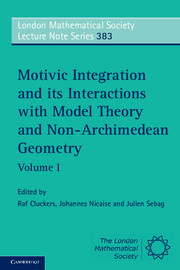Book contents
- Frontmatter
- Contents
- List of contributors
- 1 Introduction
- 2 Introductory notes on the model theory of valued fields
- 3 On the definition of rigid analytic spaces
- 4 Topological rings in rigid geometry
- 5 The Grothendieck ring of varieties
- 6 A short course on geometric motivic integration
- 7 Motivic invariants of rigid varieties, and applications to complex singularities
- 8 Motivic integration in mixed characteristic with bounded ramification: a summary
- References
2 - Introductory notes on the model theory of valued fields
Published online by Cambridge University Press: 07 October 2011
- Frontmatter
- Contents
- List of contributors
- 1 Introduction
- 2 Introductory notes on the model theory of valued fields
- 3 On the definition of rigid analytic spaces
- 4 Topological rings in rigid geometry
- 5 The Grothendieck ring of varieties
- 6 A short course on geometric motivic integration
- 7 Motivic invariants of rigid varieties, and applications to complex singularities
- 8 Motivic integration in mixed characteristic with bounded ramification: a summary
- References
Summary
These notes will give some very basic definitions and results from model theory. They contain many examples, and in particular discuss extensively the various languages used to study valued fields. They are intended as giving the necessary background to read the papers by Cluckers-Loeser, Delon, Halupczok and Kowalski in this volume. We also mention a few recent results or directions of research in the model theory of valued fields, but omit completely those themes which will be discussed elsewhere in this volume. So for instance, we do not even mention motivic integration.
People interested in learning more model theory should consult standard model theory books. For instance: D. Marker, Model Theory: an Introduction, Graduate Texts in Mathematics 217, Springer-Verlag New York, 2002; C.C. Chang, H.J. Keisler, Model Theory, North-Holland Publishing Company, Amsterdam 1973; W. Hodges, A shorter model theory, Cambridge University Press, 1997.
Languages, structures, satisfaction
Languages and structures
Languages. A language is a collection ℒ, finite or infinite, of symbols. These symbols are of three kinds:
– function symbols,
– relation symbols,
– constant symbols.
To each function symbol f is associated a number n(f) ∈ ℕ>0, and to each relation symbol R a number n(R) ∈ ℕ>0. The numbers n(f) and n(R) are called the arities of the function f, resp., the relation R.
- Type
- Chapter
- Information
- Motivic Integration and its Interactions with Model Theory and Non-Archimedean Geometry , pp. 35 - 79Publisher: Cambridge University PressPrint publication year: 2011
References
- 2
- Cited by

